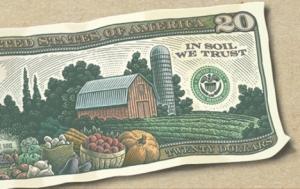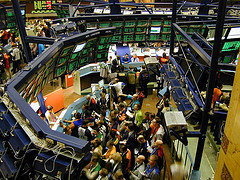Money and Investments in a Steady State Economy
In a steady state economy, people adjust their expectations about money and investing to match reality. We stop believing in get-rich-quick and Ponzi schemes, and set our expectations to receive real returns on real investments. Lower interest rates prevail, and investments are used to support local economies, improve the stock of human-made structures and machinery, and support innovative and useful technologies. Stocks, mutual funds, and other investment tools feature lower risk and more stable returns. We climb out from under the enormous heap of debt, as we learn to keep borrowing within the bounds of savings. The difference in income levels and wealth between the richest and the poorest in society shrinks – no one is left behind, and no one becomes obscenely affluent, able to consume an extreme amount of resources.
 | More of this…Local investing for local goods and services Image credit: Slow Money Alliance |
Money and Investments in a Perpetual Growth Scheme
Under the existing financial system, the money supply expands during a time of growth and contracts during a slump, reinforcing boom-and-bust cycles in the economy. When economic growth is always the goal, the frenzied search for the next boom produces speculative and wasteful investments. When the bubble bursts, someone (usually low and middle-income workers and taxpayers) is left holding the bag. Financial instruments, accounting procedures, and even money itself become more and more abstract, as they are used to cover our attempts to squeeze more growth out of an overgrown system. Credit-leveraging schemes, massive debt, and speculation lead to bigger and more harmful financial meltdowns.
 | Less of that…Frenzied trading of overly complex financial Image credit: PerpetualTourist2000 |
Exemplary Ideas for Money and Investment
The Slow Money Alliance promotes the following principles for money and investing:
- We must bring money back down to earth.
- There is such a thing as money that is too fast, companies that are too big, finance that is too complex. Therefore, we must slow our money down — not all of it, of course, but enough to matter.
- The 20th Century was the era of Buy Low/Sell High and Wealth Now/Philanthropy Later—what one venture capitalist called “the largest legal accumulation of wealth in history.” The 21st Century will be the era of nurture capital, built around principles of carrying capacity, care of the commons, sense of place and non-violence.
- We must learn to invest as if food, farms and fertility mattered. We must connect investors to the places where they live, creating vital relationships and new sources of capital for small food enterprises.
- Let us celebrate the new generation of entrepreneurs, consumers and investors who are showing the way from “making a killing” to “making a living.”
- Paul Newman said, “I just happen to think that in life we need to be a little like the farmer who puts back into the soil what he takes out.” Recognizing the wisdom of these words, let us begin rebuilding our economy from the ground up, asking:
-What would the world be like if we invested 50% of our assets within 50 miles of where we live?
-What if there were a new generation of companies that gave away 50% of their profits?
-What if there were 50% more organic matter in our soil 50 years from now?